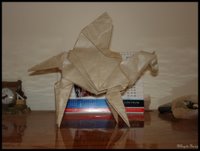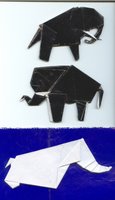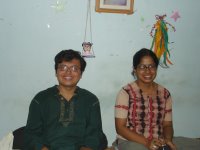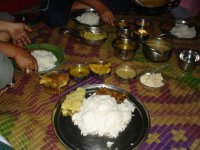One of the earliest memories that comes to my mind when I think about Rabindranath Tagore is that of my mother reading Beerpurush (The Hero) to me. Whenever she took the Sanchayita (a fat anthology of Tagore’s poems) in hand, I’d tell her to read that poem at least once.
Even before that, I knew some of Tagore’s poems by heart. My grandfather and my parents had taught me those even before I had learnt to read. But those were in the days when I didn’t know that poems needed something like poets to create them, and so Rabindranath’s name wasn’t familiar to me. Later I probably had to learn a few other poems for my primary school, but those were not for fun.
Then we went to Allahabad, and my contact with Bengali literature kind of decreased.
Some time later, once when my father visited Hooghly for a week, my grandfather sent me a small thin notebook by his hand. Inside that notebook, he had written a few poems by Rabindranath Tagore in his beautiful handwriting. The first among them was Nadi (The River). As I read and re-read that poem, my love for Tagore and poetry in general was reborn: a love which only deepened as I grew up.
This post is not to discuss or analyze Tagore’s poems; I am not competent enough to do that. But since my childhood days, his poems seemed to affect me profoundly. I have not read most of Tagore’s literary works which contains poems, songs, short stories, novels, plays, essays and letters. But by whatever I have read, I have come to a condition where it is difficult for me to live without listening to his songs or reading his poems for a few days. Even now I have a copy of the Sanchayita in my bedroom which I brought from my home the last time I went there.
One thing that I always felt was that Tagore’s work has not been translated into English properly. Whatever translations that I had read were nowhere near the original Bengali versions, primarily because the rhymes of the lines were not there. So when I decided to translate a Tagore poem in English, my priority was to keep the rhyme intact, and sticking to the meaning as much as possible at the same time. Naturally, I chose my favourite poem, Nadi. The poem describes the journey of a typical Indian river from the mountains to the sea, and is very very long, like a river itself. The language is very simple as it was written primarily for children. I showed this translation to the noted Bengali author Narayan Sanyal shortly before his death last year. He liked it and advised me to get it published. However, I write for enjoyment only, and have neither the time nor the energy to translate sufficient number of poems to form a book. At the same time, I would like the English-speaking population of the world to read this poem, so that they can appreciate the beauty of Tagore’s creation. That’s why I’m posting my translation here on the occasion of his 145th birth anniversary today.
[By the Bengali calendar, however, Tagore's birthday is on 25th Baishakh (the first month of the Bengali year) which coincides with May 9th this year]
THE RIVER
By Rabindranath Tagore (Translated by Sugata Banerji)
Hey, does any of you know
Why the water waves dance so?
They dance day and night,
Where did they learn it?
Hark! With gurgle and splutter,
Continuously flows the water.
Whom do their hands beckon?
Whose lap do they rock on?
Always bubbling with delight
They run with all their might.
Keeping everybody appeased,
They themselves remain pleased.
I often sit and wonder,
Wherefrom came the river
From some high mountain it came,
Does anybody know its name?
It has never been visited
It is uninhabited.
It has neither grass nor trees,
Nor birds, beasts or bees.
Where no sounds are heard
The mountain sits like a great bard.
On his high head
Snowy covers are spread.
Only the clouds there roam
Like the children of the home.
Only icy winds blow
Over those wastes of snow.
Only the stars of the night,
Keep him in their sight.
Only the smiling rays of dawn
Adorn him with a crown.
There, under the sky’s blue feet,
Where the soft clouds meet,
Where the white snow gleams,
The sleeping river dreams.
Once as the sun shone on her face,
She woke up in that place;
Once on a sunny day,
She remembered her play.
There she lived alone
Playmates there were none;
She heard nobody’s tongue,
There no songs were sung.
So prattling along the road,
She slowly left her abode
Thinking, “Whatever there’s to see
Won’t remain hidden from me.”
Below, on slopes not so high,
Trees have risen through the sky.
They are old trees whose
Age nobody knows.
In their joints hard and big
Birds build with twigs.
Raising their black branches,
They obscure the sun’s rays.
From the boughs here and there
Moss hangs like tangled hair,
They stand without a gap,
As if laying a dark trap.
In the silent shades below,
The giggling river does flow.
Who can keep her still?
She changes course at will.
Ever playing hide-and-seek
Pebbles rattle at her feet,
Pushing rocks on her way,
She goes laughing away.
If on the path stands a mount,
She smiles and goes around.
Wild billy-goats there graze
With beards hanging and horns raised.
And deer with thick fur
Whom none can capture.
The people there look new,
Their bodies all sinew,
Their eyes are not straight
Their words you don’t get.
They are children of the hill,
They sing as lands they till.
They toil day and night
And cut heaps of wood to light.
They climb mountaintops
To hunt wild antelopes.
As the river moves farther,
Friends come and join her.
They too, like her, have come
Out on the road leaving home.
At their feet ring the pebbles,
Like anklets and bangles.
Light sparkles on them
Like a dress of sparkling gems.
In their own babbling way
They have so much to say.
Falling over with mirth
They increase each other’s girth.
Embracing each other tight
At last they all unite.
Then the water flows so fast
It shakes the earth’s very crust.
Wherever it falls from a height
The rocks tremble with its might.
Boulders crumble by her force
The river carves her own course.
The trees on her banks are tall
They lean as if about to fall.
Large chunks of rock crash
And hit the water with a splash.
Then the muddy water flows
With bubbles in clusters close.
The water swirls around
And runs madly seaward bound.
Crossing the mountains,
At last the river finds plains.
Here whatever she does view,
To her eyes they seem new.
Open fields: her eyes they soothe
The roads are flat and smooth.
Here farmers crops do raise,
There cattle having a graze,
Somewhere on a large fig branch
A bird does a whistling dance,
Shepherd boys there meet
And play at some tree’s feet,
In the villages near her shores
People are busy doing their chores.
Now nothing obstructs her flow
She chooses the way to go.
Rainwater streams on the way
Come from all around. They
Expand the river so fast,
She is unstoppable at last.
Grass makes the riverbanks green,
That’s where herons preen.
Buffaloes live there in herds,
They roll in the riverbed mud.
The wild boars there dwell,
Their tusks dig up the soil.
So many foxes there lurk,
They howl after it’s dark.
To so many lands she travels,
The number is uncountable.
At some places there’s only sand,
At others there’s red-earth land;
Some banks are covered with cane,
Or wheat fields fill the plain;
Small villages somewhere lie,
Or a capital with head high—
The Nawab there a palace owns,
With thick pillars of stone,
Its ghats of a hundred steps
Go down to the water’s depths.
Somewhere the river’s two banks
A white stone bridge spans.
Somewhere on a bridge of steel
A train puffs along on wheels.
Travelling in this way,
At last she finds soft clay.
In course of the river’s tour,
She comes to our very door.
Here canals, lakes, rivulets
Wrap the land in watery nets.
Where girls themselves wash,
Or boys have a good splash,
Fishing nets the fishermen throw,
The boatmen boats do row,
The ferryman sings a merry song,
As the ferryboats move along.
Old temples by the scores,
They line some of the shores,
Each morning and evening,
The prayer bells there do ring.
Ascetics besmeared with ash,
Sit as if drawn with a brush.
Somewhere it’s market day,
So many boats fill the quay.
Fields have crops in such amount
That is beyond all count!
In some dense sugarcane plot,
Lone mynas feed and trot.
Where there’s only sandy loam,
It’s the bank myna’s home
There turtles their eggs lay
Under the sand and go away.
In winter in flocks come
Wild geese and make it home.
There crowds of ducks belong,
They jabber all day long.
The snipes along the shore
Go pecking the mud for more.
Somewhere beside paddy fields
Through dense bamboo-banana yields
Or groves of mango-jackfruit green
Some small village can be seen.
There grains in full barns lie,
The haystacks are piled high,
The cattle tied in their sheds,
They are black, white and red.
In the oil-miller’s small shack,
The creaking mill’s at work.
The potter his wheel whole day
Turns and models clay.
The grocer in his shop all day
At the Ramayana reads away.
Boys in classroom seats
Their lessons aloud repeat,
With the long cane in his lap,
The teacher takes a nap.
Here meandering all the way,
Village roads go far away.
A bullock cart on this road,
Goes groaning under the load.
Thin village dogs ill fed
Sniff the dust in search of bread.
When the full moon night comes by
The moon smiles across the sky—
The woods across are dark,
The water shines like sparks,
Sand glistens on the bed,
Shadows hide in shrubs in dread.
All are asleep under their roofs,
Not a single boat now moves.
The leaves on trees don’t stir,
Nor waves on the water.
If suddenly awakened by the light,
The cuckoo sings out in the night,
Across, a bird in its dream
Utters an occasional scream.
The river goes right-left, here-there,
She stops never and nowhere.
Here there’s a deep jungle—
Where the shores have no people.
Only crocodiles her banks do line,
They bask in the bright sunshine.
Tigers prowl among the clumps,
On their prey they suddenly jump.
Somewhere leopards can be seen,
They have a spotted skin—
At night they steal to the brink
And lick the water to drink.
Here when there is high tide,
The river swells up wide.
The water is brim to brim—
Fruits and flowers in it swim,
The waves laugh out loud,
Boats pitch and roll about.
The river like a python roars
And tries to swallow its shores.
Again, when the tide starts going low—
The water becomes shallow,
The river is no more fat,
On her sides are seen mud flats,
The descending steps emerge
Like the river’s rib cage.
Further the river goes
More the water in it grows.
Until you can’t see the coast,
And sense of direction is lost.
The water becomes blue,
Its taste is salty too.
Then the river becomes so deep,
To the sky the water leaps,
The land now can’t be found,
It is water all around.
Hey, what’s that noise we hear?
What’s the deep blue water there?
That the ocean must be,
Whose end none can see.
There millions of waves all rise,
Then banging its head each dies.
The white foam dances on them,
Like great anger bubbling within.
The water roars and rushes around,
As if to pull the sky to the ground.
Running the wind arrives,
Laughing into the waves he dives.
Just like a school-less boy,
Jumps, runs and plays with joy.
Here however far you view,
There’s nothing, nothing new—
Just the sky and wind and water,
Just the noise of their chatter,
Just the foam and the waves—
And there’s no one, and nothing else.
Here, at the end of all lands,
The river’s journey ends.
Here all night and day
Without end she can play.
She can sing endless songs,
Or dance all day long.
Now she can have some rest,
The ocean took her on his breast.
On a blue bed her he’ll lay
And wash her mud away.
And cover her with froth,
His wave-cradle’s bed cloth,
Singing lullabys in her ears
Make her tiredness disappear.
For eternal days and nights, here
She will lie in bottomless care.

 While in college, I suddenly discovered one day that there were a lot of Origami models that could be learnt online. This finding quickly rejuvenated my interest and I learnt several new models like the variety of elephants shown on the left. The fun of Origami is that the symbols are universal and I can follow instructions written in any language. I have managed to keep this hobby alive even after coming into the IT industry. Only, there’s a slight twist to it. These days I usually don’t buy paper but use waste paper instead. It’s quite exciting to hunt for appropriately colored paper among pamphlets, used brochures and magazines.
While in college, I suddenly discovered one day that there were a lot of Origami models that could be learnt online. This finding quickly rejuvenated my interest and I learnt several new models like the variety of elephants shown on the left. The fun of Origami is that the symbols are universal and I can follow instructions written in any language. I have managed to keep this hobby alive even after coming into the IT industry. Only, there’s a slight twist to it. These days I usually don’t buy paper but use waste paper instead. It’s quite exciting to hunt for appropriately colored paper among pamphlets, used brochures and magazines. 
 And I intend to improve. I plan to learn more and more models, for I believe that if something is worth doing, it is worth doing well. Right now I’m a bit busy with workload, but I wish to create a few original models of my own in the future. I believe Origami is creativity at its best. Looking at a square sheet of paper, one has to imagine how to make something out of it just by folding. It’s unlike painting or sculpture, where the artist is limited only by his own skill. Here the additional restriction is the paper folding. That’s what makes it more challenging. And I also believe that computers can be made to paint, or even to sculpt in the near future. But they will not be able to do Origami. At most, we can have a robot that folds a piece of paper and creates a model once the instructions are given to it. But original models? Nah! That will remain something that only we humans can ever make.
And I intend to improve. I plan to learn more and more models, for I believe that if something is worth doing, it is worth doing well. Right now I’m a bit busy with workload, but I wish to create a few original models of my own in the future. I believe Origami is creativity at its best. Looking at a square sheet of paper, one has to imagine how to make something out of it just by folding. It’s unlike painting or sculpture, where the artist is limited only by his own skill. Here the additional restriction is the paper folding. That’s what makes it more challenging. And I also believe that computers can be made to paint, or even to sculpt in the near future. But they will not be able to do Origami. At most, we can have a robot that folds a piece of paper and creates a model once the instructions are given to it. But original models? Nah! That will remain something that only we humans can ever make.




